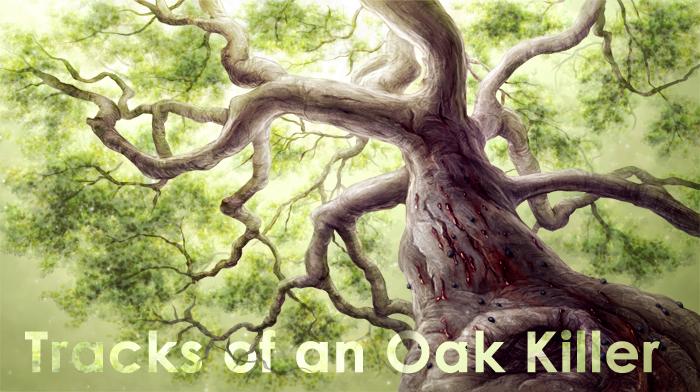
|
| Illustration: Jillian Walters |
California scientists are honing new tools to fight sudden oak death. Erin Loury joins them on the wooded trail. Illustrated by Jillian Walters and Leigh Anne Carter. |
 |
The oak tree is so massive that it takes a minute for us to spot signs of the attack. A half dozen enormous branches arch over us, dividing into twisted limbs that stretch to the ground and form a cavernous tent of shiny green leaves. My guide, UC Berkeley researcher Doug Schmidt, works his flashlight over the chest-high base of one branch. Unlike the rest of the trunk, this patch is bare of frilled lichens and tendrils of moss. “See how it’s brown and bruised here?” he says. “That’s the disease fighting its way into the tree, and the tree defending itself.”
It’s a hopeless attempt. When the weather warms, an oozing red sap will bleed from the trunk as the silent killer marches around it, severing the tree’s food and water supply. In a year or two, all life will have drained from this century-old sentinel at the entrance of Sonoma County’s Fairfield Osborn Preserve. One powerful gust of wind could snap the skeleton tree, sending its stately crown of branches crashing to the earth.
All from a bit of slime.
The culprit, known as sudden oak death, has killed at least one million of California’s iconic trees since escaping from imported nursery plants in the mid-1990s. Caused by a relative of the Irish potato blight, the disease has spawned a slow-building environmental crisis that surged in 2011 after a deluge of spring rains. A spike of infections confirmed that the disease is here to stay. Its shadow stretches from Humboldt to Big Sur, threatening a cornerstone of the state’s environmental heritage.
Now, scientists are developing new strategies to stem the onslaught. Tree injections, laboratory genetics, and droves of volunteers surveying their neighborhoods may give some oaks a fighting chance. “Fixing the problem is going to be extremely difficult,” says Matteo Garbelotto, a plant pathologist at UC Berkeley. “The disease will take its course.” But with persistence, his group hopes to slow its devastating advance against the trees that have supported California’s native people and wildlife for centuries.
Foreign invasion
Trees risk infection from a barrage of diseases, caused by bacteria or viruses or fungi. Some appear merely as leaf spots, analogous to the common cold. Others inflict more damage, but trees usually counter with chemical defenses, honed through millennia of evolutionary one-upmanship with native pathogens. Newly introduced diseases, however, with which trees have no history, can lay waste to forests just as smallpox ravaged populations of Native Americans.
The invader behind sudden oak death is called Phytophthora ramorum. The genus name appropriately means “plant killer.” An infamous relative, Phytophthora infestans, caused the blight responsible for the Irish potato famine that killed a million people in the late 1840s. While scientists call the organisms “fungus-like” because of their looks, they actually belong to a primitive group related to brown algae, such as kelp.
Scientists still aren’t sure how this disease kills a tree, but it enters an oak through the bark. The tree produces a bloody sap at the infection site, usually just a few feet above the ground, so splashes of rainwater may fling the disease onto the trunk. Once inside, P. ramorum infects the cambium, the thin living skin around the tree’s woody core. The disease attacks the tissues of the oak’s transport systems, the xylem and phloem, which ferry water and food, respectively. It eventually girdles the tree and strangles it.
Sudden oak death also makes a tree vulnerable to other invaders, like HIV does to humans. Beetles bore their way through the weakened trunk, leaving sawdust in their wake. Coal-black growths of wood-eating Hypoxylon fungus erupt from the bark. Any of these may finish off the tree, but its leaves retain their color for months or years, creating an illusion of health. Then suddenly some switch flips. Within weeks all the leaves die, leaving the tree standing perfectly formed, but dead. “They just seem to flame out,” says David Rizzo, a plant pathologist at UC Davis who has worked with Garbelotto for more than a decade.
Rizzo recalls the day he first isolated the disease species in 2000. He couldn’t identify it in his Phytophthora book. “I think back: ‘Holy smokes,’” he says. “When I looked at it under the microscope, I was the only person who knew that it existed.” Thanks to Garbelotto’s subsequent genetic work, and a serendipitous visit from a British Phytophthora expert on vacation, the researchers identified the organism as a new species also recently discovered on rhododendrons in the Netherlands. Further genetic sleuthing traced the origins of the California invasion to Mount Tamalpais in Marin County and a rhododendron nursery in the Santa Cruz mountains—tying the outbreak to the international plant trade.
The nasty neighbor
Sudden oak death requires a favorable environment to spread, and rain is key. P. ramorum belongs to a group called the "water molds," which need moisture to reproduce. Its packets of genetic material use two whip-like flagella to swim toward a new host. Their packets of genetic material use two whip-like flagella to swim toward a new host.
Garbelotto sums up prime conditions for sudden oak death in a few words: “A lot of rain in the spring.” The ideal combination of warmth and moisture after an El Niño season in 1998 triggered a mass oak die-off a few years later. The disease similarly spiked in 2006 and 2011.
Figuring out how the disease finds its hosts initially baffled researchers. It didn’t appear to spread from oak to oak. Instead, scientists discovered the botanical equivalent of Typhoid Mary: the California bay laurel tree. “The most surprising [finding], and this will be until I die, is the fact that bay laurels were carriers,” Garbelotto says. “We just had no idea.”
|
Erin Loury narrates a slideshow on sudden oak death, which is killing trees across large swaths of northern and central California. (Click on image to see video.) |
|
|
The discovery essentially was an accident. In 2001, Rizzo sent Garbelotto a handful of bay laurel leaves, mostly as a joke, to test out his newly developed molecular detection methods for P. ramorum. He was sure the leaves would test negative. But when Garbelotto showed that bay trees are actually “super spreaders” of sudden oak death, it changed the entire course of studying and managing the disease.
I see the tangled ecological relationship between oaks and bays on my visit to the Fairfield Osborn Preserve with Schmidt, a research associate in Garbelotto’s lab. Sonoma State University manages this wooded hilltop, golden with dry grasses, which only educators and researchers may enter. Schmidt has come to collect a piece of malfunctioning equipment—a rain-triggered machine that vacuums P. ramorum spores out of the air. The researchers want to pinpoint when bay laurels release spores of the disease after a heavy rainfall. I don’t know what sudden oak death looks like, so I ask Schmidt to show me.
It’s almost too easy. We spot the disease on the first oak we examine, the stately gatekeeper at the preserve’s entrance. The source of the killer lurks a few yards away. Our feet sink into a thick carpet of dead leaves and twigs as we crunch over to a tree just outside the oak’s umbrella canopy. Schmidt pulls over one of its long narrow leaves for me to smell. The pungent medicinal scent identifies it as a California bay laurel leaf, chock full of aromatic compounds that deter many animals.
But this leaf harbors more than scent. Schmidt points to its tip, grayish-brown as though dipped in mud. A black line separates the tip from a thin yellow halo, which bleeds into the green leaf. These are the classic signs of sudden oak death. Craning my neck, I see the bay’s branches mingling with the mighty oak overhead. The pathway of infection is clear: death foisted on a neighbor powerless to move away.
The role of bay trees forces land managers to decide whether to sacrifice one native species to save another. Oaks can’t pass the disease to one another, so removing bay laurels within 15 feet of an oak can greatly improve its odds of survival. Bays are efficient sudden oak death factories; the mold can complete its entire life cycle on a bay laurel without killing it. “[The disease] doesn’t need oaks,” Rizzo says. “From an evolutionary standpoint, it doesn’t care if it kills every single oak.”
Sudden oak death won’t get them all. Perplexingly, the disease kills only some oak species—such as coast live oak, black oak and Shreve’s oak—but doesn’t infect white oak or valley oak. More than 100 different native and ornamental plants, from ferns to redwoods, can host P. ramorum. The capricious invader damages leaves in some species and stems in others, kills a handful, and is merely a nuisance to the rest. Of California’s native plants, the hardest hit is tanoak. This close oak relative catches the disease in leaves, twigs, and trunk. Because their infected leaves host spores, tanoaks can spread the disease to one another, unlike the true oaks.
Giving oaks a shot
But even the most susceptible trees have a chance to survive. A decade ago, Garbelotto’s lab conducted experiments using various chemicals that thwarted other Phytophthora species. The scientists found that phosphites, the salt of phosphonic acid, could protect a tree that had not encountered the disease. “It’s the first time we’ve been able to prescribe treatments” for a forest disease, Garbelotto says. Phosphite boosts a tree’s defense response, priming it to fend off a future strike from sudden oak death. However, there is still no cure for an infected tree after the disease attacks.
 Illustration: Leigh Anne Carter Illustration: Leigh Anne Carter
|
Garbelotto gives regular seminars to show tree owners how to apply Agri-Fos, a readily available phosphite solution, either by injecting it or spraying it over the bark. Injection requires drilling small holes around the trunk, then inserting the phosphite with syringes—essentially giving the tree a shot. It costs money and requires a booster every year, but the treatment offers some protection for prized individual trees.
The key to saving whole oak populations, however, may lie in their DNA. Garbelotto and his colleagues have found a small number of trees throughout California that, while not immune, are less susceptible to sudden oak death. The scientists are searching for the traits, and underlying genetic blueprints, that give these trees an edge. One day, we might cultivate oaks that can better cope with disease. “The final goal would be, can we help the forest help itself by making things more difficult for the pathogen?” Garbelotto says.
They have also identified the conditions and time of year when bay laurels and oaks are most vulnerable: rainy spring seasons when trees grow the most, shunting food and water through their tissues. Climate change complicates this synchrony. Drought thwarts sudden oak death spread, but warming temperatures might one day allow any spring rain to trigger disease outbreaks.
Volunteer mappers
Scientists also have used remote sensing technology to study sudden oak death from above. Maggi Kelly, a geographer at UC Berkeley, helped map the disease in Marin County after a major oak die-off in 1999. For four years, she made surveys with an airplane-mounted camera that takes pictures in near-infrared light, the wavelength used in night-vision goggles. How leaves absorb or reflect this light can distinguish live trees from dead ones, and oaks from bays. Kelly’s mapping corroborated the work of scientists on the ground by confirming that dead oaks often were close to bay laurels.
Kelly also realized that documenting the disease over a wider geographic area required more eyes on the ground. So in 2001, she developed a website called Oak Mapper, a Google-based map where the public can report sudden oak death sightings. The site has since sprouted into an iPhone app. Involving citizens is one way to track a disease with little funding, Kelly says. “We have a very active and interested populace who can go out and look on their hikes, on their bike rides, and they can flag areas of concern,” she says. “[The disease is] not everywhere, so let’s draw some lines around it.”
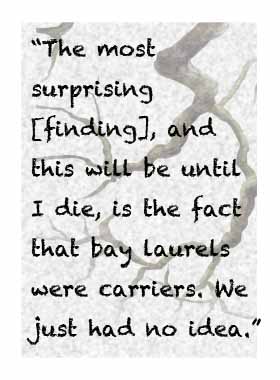 Garbelotto also involves citizens through events called Sudden Oak Death (SOD) Blitzes. Just as scientists study mosquitoes to monitor the spread of malaria, the SOD Blitzes concentrate on bay laurel trees. In each participating community, volunteers gather on a Saturday morning to hear Garbelotto’s primer on sudden oak death biology and identification. Then, armed with collection envelopes, flagging tape, and data sheets, they fan out. They record the location of potentially diseased bay laurels and collect leaves, which Garbelotto and Schmidt take to their lab. Each year, the researchers produce a Google-based map showing the location of each sampled tree and whether it tested positive for P. ramorum. Garbelotto also involves citizens through events called Sudden Oak Death (SOD) Blitzes. Just as scientists study mosquitoes to monitor the spread of malaria, the SOD Blitzes concentrate on bay laurel trees. In each participating community, volunteers gather on a Saturday morning to hear Garbelotto’s primer on sudden oak death biology and identification. Then, armed with collection envelopes, flagging tape, and data sheets, they fan out. They record the location of potentially diseased bay laurels and collect leaves, which Garbelotto and Schmidt take to their lab. Each year, the researchers produce a Google-based map showing the location of each sampled tree and whether it tested positive for P. ramorum.
Debbie Mendelson has organized an annual SOD Blitz since 2008 in her town of Woodside, just west of Palo Alto. A self-described activist, Mendelson says she respects how a single tree can provide everything from wood to shelter, from food to fuel. “As fast as we can pollute, it stands there filtering our air for us,” she says. “It does so much and asks so little.” Mendelson has 14 oaks on her property, and every year she asks her gardener to spray them with Agri-Fos. By collecting leaves for scientists to test, she tells her fellow volunteers, “We can be part of the chain that makes the difference.”
Garbelotto says SOD Blitzes can help people keep tabs on the disease and decide whether and when to invest money in protecting their oaks. In 2011, volunteers collected samples from more than 1,800 bay laurels across the Bay Area. Mendelson’s neighborhood of Woodside and Portola Valley ranked second in the rate of positive samples: 70 percent of the nearly 350 trees tested. The results made it clear that sudden oak death infections jumped between 2010 and 2011 after a wet spring.
Saving the keystone species
Such extensive efforts reflect the importance of oaks to California’s ecosystems. Oaks stretch deep into California history; their large acorns were dietary staples for many Native Americans. Sudden oak death threatens the cultural heritage of tribes like Sonoma County's Kashaya Pomo, which has a strong connection to tanoaks. In 2006, tribe members teamed up with Garbelotto’s lab to test Agri-Fos on their trees. “The acorn is a major cultural element,” says Ted Swiecki, a plant pathologist who assisted with the project. “It’s not just food, it’s a connection back to their roots, their traditional life.”
To lose an oak is to lose critical forest shelter and food supply. Birds, mammals, and insects feast on an oak’s acorns and find lodging in its trunk and branches. An oak’s gnarled roots serve as house and larder to fungi. Mushroom hunters frequently seek out oaks and tanoaks, searching for choice fungi that form symbiotic relationships with tree roots. A half dozen such species grow only on tanoaks. But avid mushroom hunter Christian Schwarz of Santa Cruz says that more than the loss of mushrooms, he fears the permanent loss of habitat after oaks die. “It would make it so much easier for people to swoop in and build a Walmart,” he says.
Tree death is natural, but massive tree die-offs caused by sudden oak death can throw a forest’s ecological balance out of whack. Trees killed by disease become standing tinder. Indeed, Rizzo’s lab is studying how sudden oak death affected the massive Big Sur fires in the summer of 2008. Their work suggests that standing dead trees fueled high-intensity crown fires, while long-smoldering logs from fallen diseased trees inflicted greater soil damage.
While sudden oak death infects plants, people boost its spread. Through the global nursery industry, which equates “beautiful” with “exotic,” we ship plants around the world—and risk sending their diseases along for the ride. Preventing such disease introductions is crucial, Garbelotto says. Once a plant pathogen escapes into a brave new wild, there’s nothing that can stop it.
This may leave some people wondering whether tackling sudden oak death is worth the fight. “A lot of people think if we don’t have oaks, so what? The forest is still green,” Garbelotto says. “I beg to disagree. In some cases, losing one keystone component is a loss that we need to avoid at all costs.”
As we prepare to leave Fairfield Osborn Preserve, Schmidt loads the temperamental spore collector into his van. He suspects mice have gnawed at the wires. I take one more pass around the giant infected oak at the gate. There is nothing to be done. The tree may still have a few years left, but I am seeing its century-long life come to an end. I trudge back to the van, and a red-tailed hawk loops overhead as we drive down the hillside. The oak stands where it always has, and where, all too soon, it will return to the earth.
Story ©2012 by Erin Loury. For reproduction requests, contact the Science Communication Program office.
Top
Biographies
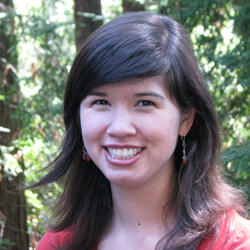 Erin Loury Erin Loury
B.S. (biology) University of California, Davis
M.S. (marine science) California State University/Moss Landing Marine Laboratories
Internship: Los Angeles Times (Kaiser Family Foundation health reporting internship)
My designs on becoming a writer started in the third grade, after hearing my teacher read one of my stories to the class. I was exhilarated; my words had taken on life, like the books I read so insatiably. I kept finding ways to write as I pursued my love of nature by studying the ocean as a marine biologist. Between catching fish in protected areas at sea and studying their stomach contents in the lab, I created a blog for my graduate school. We used it to transport readers into the world of marine scientists, to showcase the diversity of ocean creatures and the challenges they face. Writing about science helps me interlace two distinct parts of myself: the curiosity and discovery that tantalize my mind, and the artistry and creativity that captivate my heart.
. . . . . . . . . . . . . . . . . . . . . . . . . . . . . . . . . . . . . . . . . . . . . . . . . . .
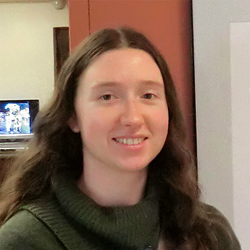 Jillian Walters Jillian Walters
B.S. (ecology, behavior and evolution; interdisciplinary computing and the arts) University of California, San Diego
Internships: Monterey Bay Aquarium, Image Resources; Pinnacles National Monument, Condor Recovery Program
Born into a family of scientists and raised among the forests of Monterey, I became the unique member with strengths in both biology and art. I enjoyed discovering new things about the environment, particularly as a bird watcher, and expressing the wonder of those findings on paper.
I received six years of private studio instruction, attended California State Summer School for the Arts, and had my first solo exhibit by age 15. In college I studied biology but taught myself digital painting on the side, thrilled with its trial and error malleability and finding ever new ways to render a subject.
The Science Illustration Program has shown me even more ways to render biological subjects, both traditionally and digitally. Now I look to the future where I will continue to contribute my skills and express my inquisitive nature. See my website to view that ongoing endeavor.
. . . . . . . . . . . . . . . . . . . . . . . . . . . . . . . . . . . . . . . . . . . . . . . . . . .
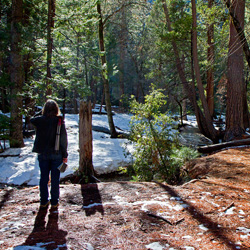 Leigh Anne Carter Leigh Anne Carter
B.A. (studio art) and B.F.A. (creative writing) University of North Carolina, Wilmington
Internships: Smithsonian Institution National Museum of Natural History (Washington, D.C.); Great Smoky Mountains National Park
Throughout my childhood I was completely absorbed with nature and art. Pursuing both subjects separately, I never quite put them together until an epiphany led me to the Science Illustration Program. I am thrilled to be in a career that combines my two loves and allows me to continue to explore my innate fascination with natural phenomena. In choosing the life of a science illustrator, I hope to inspire others to be just as respectful and curious about the natural world as when we were children. Please visit my website to see examples of my work.
Top |

